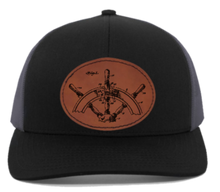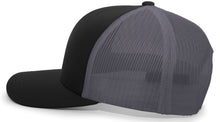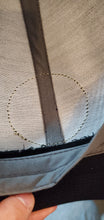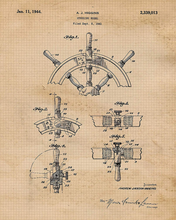Ship Wheel engraved Leather Patch hat, Industrially sewn on by hand to ensure the highest quality!
Adjustable size- 6 3/8 (51cm) to 8 (64cm)
A mesh hat has the ability to let your head breathe. All of the heat will get released through the mesh so the sweat doesn't build.
Custom logos or designs are always available under our design your own engraved products, Design your own leather patch hats online here, Patches are engraved and sewn on, and patch options will be round, oval, and rectangular.
"Get Inspired" with JTM VINTAGE  ®
®
History facts:
The Evolution of the Ship Steering Wheel
The invention of the ship steering wheel was a huge leap forward in nautical technology, as the antiquated whip staff was a markedly inefficient way for navigating a ship. Unfortunately, the ship's wheel as we know it today was not invented until ships had been navigating the world's waters for many centuries. Before this, the old whip staff technology was used for many centuries. The invention of the ship steering wheel is credited to the British Royal Navy, though there has been much debate and speculation on the true origins, as no sufficient evidence exists to support the actual first use of the ship steering wheel. While this is the "official" story, many historians contest that the actual ship wheel was more likely invented by common dock hands and artisans rather than the British military itself. To get the complete story of the ship wheel's invention, the archives at the Greenwich National Maritime Museum has a complete official record of the ship steering wheel's invention.
The first ship steering wheels are believed to have been implemented sometime around 1703. This date is only conjecture, however, based on several known ships of that time that are seen to make use of early versions of the ship wheel. If 1703 is the first time ships are seen to be implementing the new steering wheel, it may well have been invented many years before that and simply required time to become accepted into the mainstream.
Early Ship Steering Wheels
Early ship steering wheels sat above the tiller's end and behind the mizzen mast. Due to the placement of the wheel, it often obstructed the helmsman's view in hazardous ways. Originally, the ship wheel was placed in front of a cylindrical barrel. Because larger ships were especially difficult to control, it often required the strength of two sailors in order to keep the ship heading in the correct direction. Unfortunately, having two men steering the ship simultaneously in a small space often had them colliding and jockeying for position. By 1740, some ships began to be manufactured with 2 separate wheels to allow for more helmsmen to effectively steer at the same time.
One other common issue was an uneven amount of slack given to the tiller ropes. A common symptom of this problem was the wheels could not be centered as they were originally, causing the ships to drift one way or the other without an adequate amount of control. This caused the rope to either become too tight or too slack. It was not until many years later a ship engineer named Pollard invented a new system to address this growing problem. Pollard's system was comprised of "sweeps and rowles" that were tested under Captain Bentinck in 1771. Pollard's system was a critical success, and it became used as the standard by 1775.







